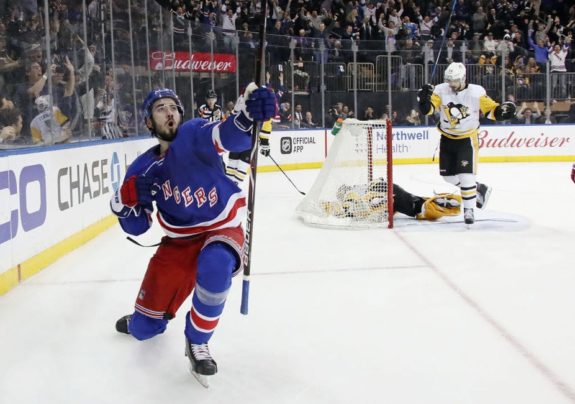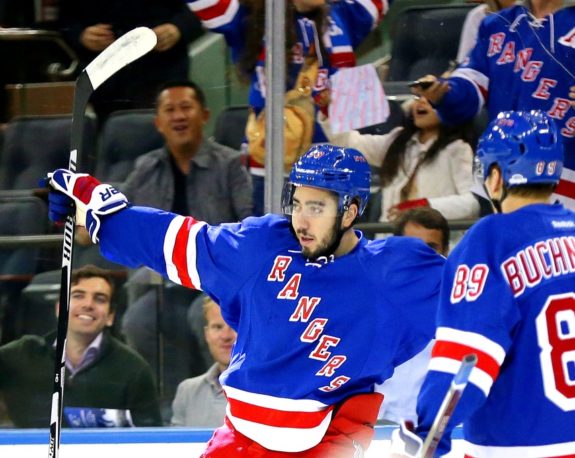Over the last six weeks or so, the Rangers power play has been one of the league’s elite units. Despite constant line shuffling and a number of different quarterbacks at the points, the unit has been explosive through the last 21 games. While a rebuilding team might not want to feature a unit capable of keeping this team competitive in the short-term, the final weeks of the season are proving that the power play is a building block for the future.
Top Marks for Rangers Power Play
Seemingly in spite of a front office committed to forfeiting this season, the Rangers have had one of the best power plays in the NHL since the management’s letter was published on February 8. With a power play percentage (PP%) of 29.1, New York ranks third in 21 games. It trails only the Capitals, who have a PP% of 29.3, and Maple Leafs, at 31.4%. Unlike those two teams, however, the Rangers man-up units don’t depend on a true star. While Alex Ovechkin and Auston Matthews are explosive scorers instantly bolster any group on their own, the Rangers are succeeding through a collective effort.

Excluding players who were jettisoned at or before the trade deadline, 14 different Rangers have recorded at least one power-play point since February 8. Mika Zibanejad, who has averaged more power-play ice time than any other player, leads the scoring with eight points 20 games since his return from injury. Four players, Chris Kreider, Pavel Buchnevich, Kevin Hayes and Neal Pionk, all have five, while Tony DeAngelo has tallied four.
The Rangers’ power play has been even better since the trade deadline itself. Since the February 26 mark, the Blueshirts still rank third but have an improved PP% of 30.0 in a dozen games. In continuing to shrink the sample size, the numbers get even better. Over the last six games, New York has converted at a 47% clip, leading the league, and registered eight power-play goals (PPG). Only the Islanders and Capitals have as many during that period. So while the Rangers get further away from meaningful games and closer to the draft, the power play is hitting its stride.
Zibanejad Leading the Way
Even though Kevin Shattenkirk was signed to be the catalyst for an improved Rangers power play, it’s Zibanejad who has proven to be the key. When he is shooting well and creative at the the right faceoff circle, the unit clicks. Regardless of who else is on the roster, the power play numbers have been largely dependent on him.
That was plainly apparent when Zibanejad missed nine games at the end of November and in December with a concussion. Over that stretch, the Rangers had a PP% of just 18.5, ranking 19th in the league. Before then, they ranked eighth at 22.8% and, though it took time for Zibanejad to regain his form, they’ve converted at a 23.2% clip, good for ninth in the league, since his return. Simply put, with Zibanejad in the lineup, the Rangers have a top-10 power play in the league. Without him, they’re in the bottom third.

All told, Zibanejad leads the rangers with 14 goals and 21 points with the man advantage, and has also registered seven assists. Among centers across the league, he’s tied for second in PPG with Evgeni Malkin and Tyler Seguin, and is just one behind Steven Stamkos, who has played 10 more games. Zibanejad’s 23.7% shooting percentage on the power play shows not that he’s lucky but that, when he’s on, he can be deadly, despite the fact that he doesn’t have the star power of some of his peers in this context.
Rangers Power Play Immune to the Rebuild
As the Rangers build for the future, they’ll be certain to continue to emphasize the power play. As we saw at times in the first half of the season, effective special teams can help carry a team to wins even when five-on-five play isn’t sterling. We saw it again against Buffalo on Saturday night, as back-to-back power-play goals closed the door on the Sabres.
What the Rangers’ man-up units will look like next year is anybody’s guess. While we can assume the Zibanejad, Kreider and Buchnevich will be fixtures, there are plenty of skaters who will look to fill roles. Ryan Spooner has been good on the power play in his career, Vlad Namestnikov has the talent to be impactful, and with a bit more muscle, Jimmy Vesey could carve out a role at the front of the net. Plus, Lias Andersson and Filip Chytil are going to get every opportunity to thrive.
On the blue line, Tony DeAngelo was dynamic before getting hurt, Neal Pionk has used his time there to push his scoring streak to eight games and Brady Skjei should, by default, take any ice time that Ryan McDonagh had there. And, of course, Shattenkirk, who is itching to get back onto the ice, will have his say.
But no matter who Jeff Gorton keeps with the team and who laces up on opening night, the current iteration of the Rangers’ power play shouldn’t be a victim of the rebuild. It will be a vital asset if the Blueshirts want to expedite their rebuild and have any sort of success next year.